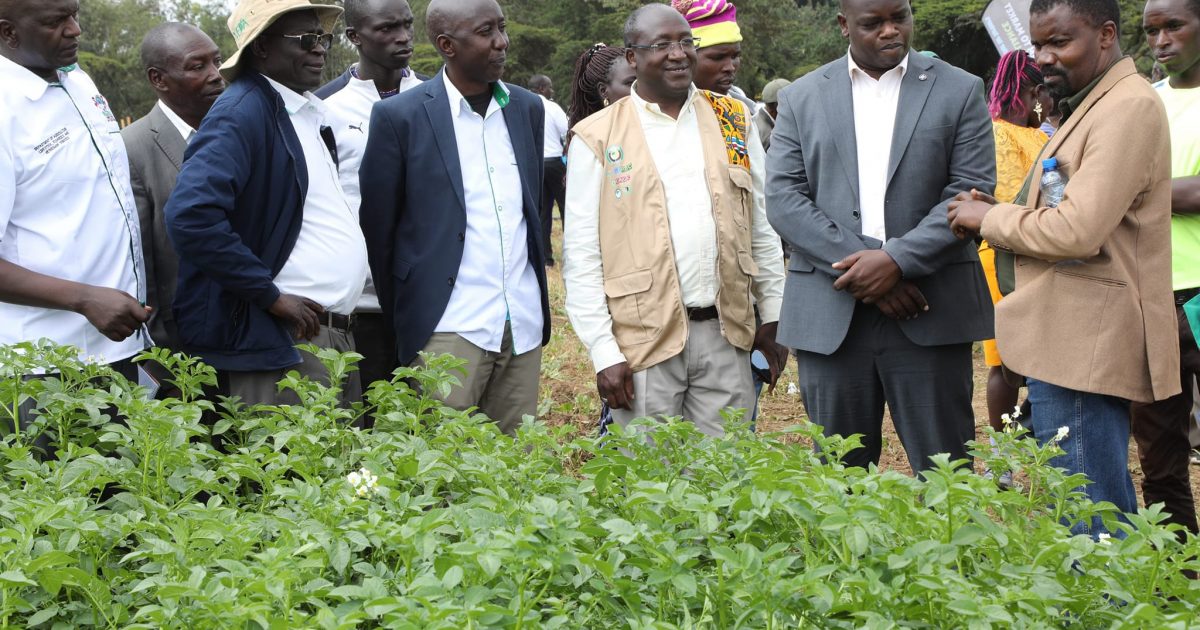
For decades, large scale and small-scale farmers in Kenya have been planting religiously every season without paying attention to soil health. Consequently, this has led to dwindling productivity at farm level as farmers wrestle with the worst effects of climate change coupled with high cost of farm inputs. It is against this background that the County Government of Nakuru is championing Conservation Agriculture (CA) to enable food producers cut costs while attaining higher yields on grounds that the practice helps retain soil moisture, ensures minimal disturbance and improves fertility.
According to County Executive Committee Member (CECM) for Agriculture, Livestock and Fisheries Mr Leonard Bor, unlike the conventional method where one uses disc plough and runs several operations, in conservation agriculture, farmer uses a special tilling machine, meaning one does a few operations at a given time. “This practice ensures that there is minimal soil disturbance or burning of the crop’s stalks or materials. This improves microorganism activity in the soil and builds up organic matter in the soil resulting in better uptake of nutrients by crops,” stated Mr Bor.

Speaking during an agribusiness field day in Nakuru organised by the County Government in collaboration with the East Africa Grain Council (EAGC) and Kenya Agricultural Livestock Research Organization (KALRO), the CECM indicated that Kenya, just like the rest of Africa is losing its farmland productivity at a high rate. He explained that conservation farming practice works on three principles-First permanent soil cover that ensures moisture retention and building up of humus in the soil and second minimal soil disturbance that reduces erosion. The system also works on the principle of crop rotation that replenishes soil nutrients especially nitrogen fixation by legumes and reduces exhaustion of nutrients by heavy feeders such as maize.
The idea, Mr Bor mentioned, is to rotate cereals and legumes as well as leave land fallow for some time. The CECM noted that yields have been declining due to loss of soil nutrients and hardening of soil blamed on bad agricultural practices due to ploughing machines. The field day was themed ‘climate-smart technologies and practices for sustainable food systems’.
He indicated that the way most farmers plough their land hardens or compacts soils so that when it rains water does not percolate but instead runs off, adding that there were now special tiller machines that can remedy the situation. Mr Bor stated, “The country’s current agricultural development plans project food security that can only be achieved if Conservation Agriculture (CA) is aggressively adopted by farmers of all sizes. Indeed, farming the CA way has a new dimension in a period of Climate Change, calling for Climate Smart Agriculture (CSA).
” The CECM observed that there is a need for sustained innovation in areas like drought resistant varieties of seeds, environment friendly farming practices and better post-harvest management to reduce losses. Dissemination of information to farmers across the country, he added, is also key in the implementation of climate proofing agricultural value chains. He expressed concern that every year Kenya was losing ‘unforgivable’ volumes of fertile top soils that favour crop and livestock farming, to erosion, not only on sloppy, but all agricultural lands.
Hard pans, developed by hoe and mould-board farming of the past, cause flooding and erosion, to the detriment of sustainable farming practice and food security, the CECM noted. Mr Bor indicated that with erratic weather patterns, a crop cultivated under conservation agriculture can survive longer even in prolonged delays of rainfall. “Sometimes rains can delay for weeks, but if you compare with farms that were planted with conventional methods, the crop condition is different because it starts to wilt for lack of adequate moisture in soils,” he pointed out.
He said the system of farming also cuts production costs such as tilling expenses. Under conventional farming, the CECM elaborated a farmer ploughs the land three times before planting. Each tilling costs an average of Sh 3,000 meaning the farmer incurs high costs.
Mr Bor explained that the devolved unit was also promoting climate smart agricultural activities to allow farmers to adopt eco-friendly practices to mitigate impact of climate change. In conservation farming, farmers are also encouraged to use certified seeds, engage in proper management practices from planting to harvesting and using the right fertilizers to attain high yields. Practicing Conservation Agriculture (CA) means farmers fitting themselves in landscapes and learning ways of increasing soil health and productivity per unit of land (sustainable intensification), other than putting more land under production, as a way of increasing overall produce volumes available at harvest time.
The CECM stated that farming the CA way means incorporating soil structures that prevent soil erosion where there is slope. It means planting trees to protect soils and creating clever tree-crop and livestock-crop mixes that keep the soil healthy, so that it can sustainably feed plants and animals alike. “This means leaving soil covered and previous crop harvested in a way that its roots enhance on-location (in-situ) rainwater harvesting, encouraging more percolation than runoff.
Soils that are covered with mulch or cover crops, retain healthy soil fauna and pH, environments good for carbon sequestration and good for converting fertilizers and manure to forms palatable by the crops,” he added. He affirmed that Conservation Agriculture (CA) is environment friendly and promotes farming in harmony with nature. Mr Bor pointed out that where a plough, several harrows and a planter are needed for establishing a crop, a single CA Direct Seeder (on un-ploughed land) needs only a fraction of the labour and machine power required, hence huge savings in getting the planting done.
Mr Bor indicated that the CA practices lead to up-to 4 times the produce volumes from the same land. Through CA he added farming is made easier and inputs per tonne of yields achieved easier, making the venture attractive to youth and helping meet the dream of sustained food security in Kenya..














